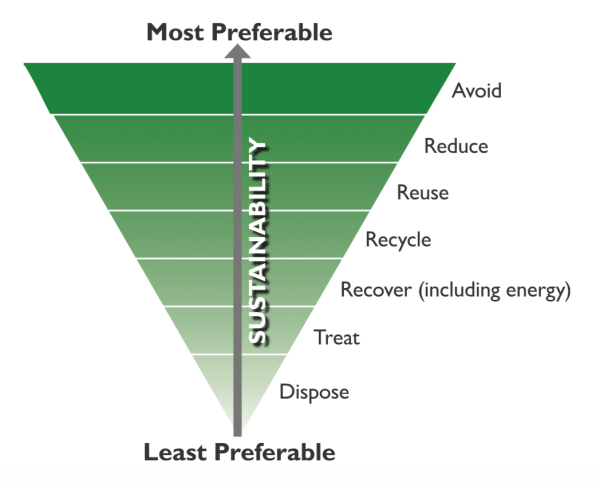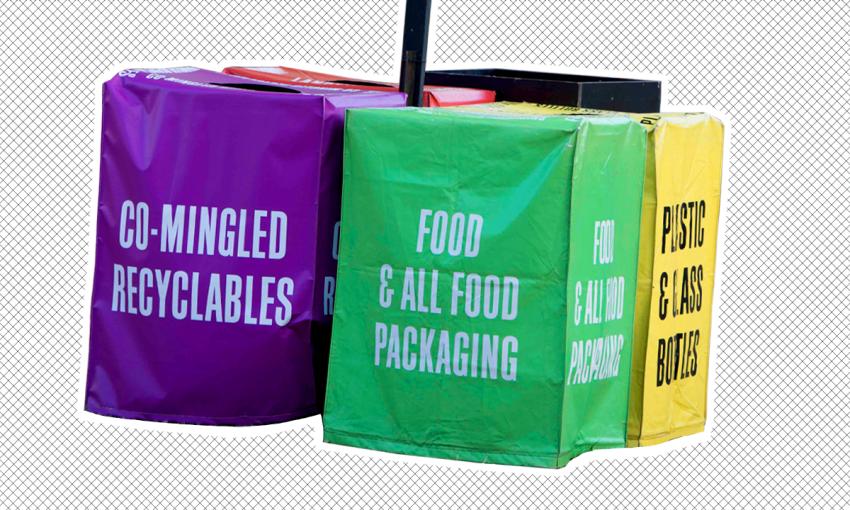We can't brag about hosting the ‘biggest fringe festival in the Southern Hemisphere’ without also worrying about the environment.
Total rubbish: Just how much waste does Mad March create?
Adelaide is a frenzy of festivals from, well, today until some time in March.
The three major art events (sorry Supaloop Adelaide 500 if you feel excluded) attracted more than 3.16 million patrons last year. (The Adelaide Fringe boasted 3.3 million attendees and the Adelaide Festival drew 316,129 patrons, including 90,000 WOMADelaideans).
That’s a lot of extra people in our city. And a lot of people create a lot of garbage. CityMag wanted to find out just how well they do when it comes to the trash they and we (their patrons) create.
Garden of Unearthly Delights and Adelaide Fringe
The Garden of Unearthly Delights (GOUD) was supplied more than 141,000 cutlery items by local product supplier Salute in 2019, the company told us. This includes 10,000 compostable food trays, 28,000 wooden forks, 90,000 square BioPak containers, 90,000 corresponding container lids, 10,000 coffee cups and 13,000 sugarcane plates.
But what does the GOUD do with these items after they’re disposed of? Waste company Veolia says they removed approximately 170 tonnes of waste – over half of that went to landfill (90 tonnes), a little less than that was recycled (80 tonnes) and roughly a quarter of what was recycled was composted (28 tonnes). It’s unknown whether the waste was reused.
(FYI it takes a standard plastic cup 450 years to break down, 400 years for six plastic beer rings, and 30 years for your run-of-the-mill coffee cup. BioPak cups completely biodegrade within 120 days.)
The best way to manage waste is to avoid using materials all together, argues the South Australia’s Waste Strategy for 2015 to 2020. The worst thing to do is to send it to landfill. Other alternatives – from most preferable to less – include reduce, reuse, recycle, recover (including energy), and finally treat waste. A point this framework stresses is the need to “conserve materials and energy by acting to avoid waste and reduce wasteful consumption.”

The waste pyramid. Source: Green Industries SA
A concern for “reused” material – something which is used, returned, washed and ready to be utilised again – a supplier told us anonymously, is that these items can be taken from the premises, and unlike compostable material, eventually end up in the Earth, taking many lifetimes to break down.
It’s hard to pin down just how much waste is produced across the designated Adelaide Fringe venues, as there are 40 restaurants, clubs and tents which host artists and crowds, and abide by their own waste policies. However, all the Fringe’s left-over cardboard is collected and recycled, and some of the Fringe Club is decorated by some of it, their sustainability policy says.
The bad news is Veolia tells us at present cardboard does not have a commodity value, and it’ll cost waste managers to shift recyclables rather than sell it to China – where it used to go up until July 2017.
Adelaide Festival
The historical arts extravaganza Adelaide Festival produced about two tonnes of waste during its opening night concert in Elder Park, waste removal pros Australian Green Clean told us. Of that, about 74 percent was recycled (1.499 tonnes), roughly 13 per cent was composted (260 tonnes) and 12.65 per cent (0.255 tonnes) was reused. None went to landfill.
Collectively from 2019, none of the waste from their outdoor sites went to the tip, but the amount of waste indoor venues produced and where it went remains unclear. The aim of 2020 is to get items from inside spaces from going to the junk heap.
Pivoting back to that opening night, the Adelaide Festival recycled a whopping three quarters of its waste. Scouts Australia, which collects and sorts through selected recyclable bins, roughly earns $50,000 – that’s 20 grand shy of an average full-time South Australian yearly wage – every year from the Mad March period.
They do this by sorting through recycle bins, finding bottles with deposits and auctioning them off to third-party companies, they said. Those companies will them drop off the vessels into to South Australia’s four-decade old innovative bottle deposit system, where an empty beer bottle or cider tinnie is worth 10 cents.
On another cool Adelaide Festival note, as of last year the Festival was the first arts festival in Australia to be certified carbon neutral. This year it aims to offset all its carbon emissions – estimated to be just over 9000 tonnes – across travel and accommodation through the investment of $18,000 in a wind power project in Gujarat, India.
Six-day literary festival Writers Week, which sits under the Adelaide Festival banner, produced about 7.3 tonnes of waste last year – none of which went to landfill, and was also collected by Australian Green Clean.
Of that waste almost 24 per cent was composted (1.780 tonnes), 45 per cent was reused (3.330 tonnes) and 30 per cent was recycled (2.141 tonnes). The Writers Week programs are also printed on FSC- certified (Forest Stewardship Council) paper, meaning the program pages are sourced from trees belonging to responsibly managed forests.
Adelaide Festival’s now-defunct waterside venue the Palais similarly created 7.309 tonnes of waste last year. Australian Green Clean told us almost 40 per cent of that was recycled (3.901 tonnes), six per cent was composted (0.630 tonnes), and 54 per cent went to reuse (5.640 tonnes). Astoundingly again, none went to landfill.
WOMADelaide
While we couldn’t find out how much waste WOMADelaide produced, we were told it diverted almost 98 per cent of its waste from landfill last year. Cable ties and nappies, which degrades after 500 years, are usually a large culprit of what goes into the ground.
Australian Green Clean supplied over 700 bins to this world music festival, and in 2018 cleaned up five million white duck feathers as part of a giant, fluffy immersive performance titled Place des Anges. Some took to social media saying that for a festival touting environmentalism, “dumping a tonne of feathers all over a park is not a good look.”
Australian Green Clean deals with a sizable chunk of South Australian festival waste. Over the Mad March period they told us they collected roughly 113.75 tonnes of total waste: 14 per cent was composted (15.88 tonnes), 11 per cent was recovered to be reused for energy (12.86 tonnes), 17.7 per cent was recycled (20.15 tonnes) and over half, 57 per cent (64.86 tonnes), went to landfill. Although they couldn’t reveal which festival created the most trash, the largest event generated 70 tonnes of waste – which is a little less than one tenth of total Mad March rubbish.
Aside from the trash talk, WOMADelaide has committed investing every $2 from ticket sales into native tree planting. More than 70,000 native trees have been planted across 65 hectares of the WOMADelaide forest in 12 years – offsetting 16,250 tonnes of carbon emissions – with another forest underway.
What’s our verdict? The only way to not produce any waste, or use any resources, is to not have a festival (AKA have no fun). However, as we spend time on Earth and bask in the warm summer sun, and consume all its tasty treats, confusing art and deafening music – it’s good to be mindful about the resources we’re using. A lot is being recycled, some is being re-used – but we can do better.




